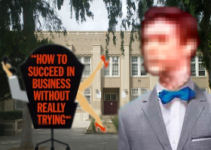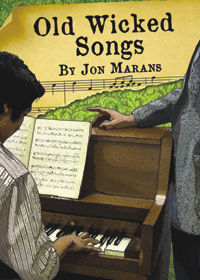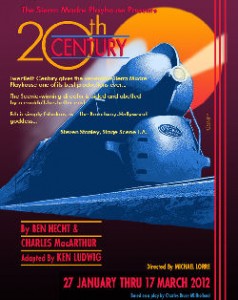
 This has been a crazy weekend. I’ve already talked about the whirlwind trip to Cal, but I neglected to tell you how it started: a trip to the Pantages to see a dancing boy.
This has been a crazy weekend. I’ve already talked about the whirlwind trip to Cal, but I neglected to tell you how it started: a trip to the Pantages to see a dancing boy.
Our crazy day Saturday actually started with 8pm non-refundable, non-exchangable tickets at the Pantages; further, while we were seeing Billy Elliott at the Pantages, Erin was seeing American Idiot downtown with a friend. Add to this a dinner that was more expensive than I expected (but good), a back that was (and still is) acting up, and some other unnamed factors, and I wasn’t in the best of moods going in. So what did I think of the show? Pretty good, in spite of all that.
Billy Elliot: The Musical basically tells the same story as the original movie did: It is the story of a boy who discovers he loves ballet dancing, in the context of a hard-scrabble Northern England town where the life is coal mining, and that life has been thrown in limbo by the national strike of the coal miners against the UK government. So you have two parallel stories: a boy discovering dancing, and a town where there miners are facing the British police, hating Margaret Thatcher, and seeing the end of a way of life. They seem like incongruous stories, but somehow they work together, augmented by the music and the story. Luckily, the stage version featured a book by the author of the movie, Lee Hall, who also did the lyrics. The energetic music was by Sir Elton John.
What makes this production is the dancing. In particular, the dancing of the young Billy. This effort is so strenuous that there are four Billys that rotate over the various performances. “Our” Billy was Zach Manske, a 12 year old from Minnesota who did a remarkable job in full-on ballet sequences, as well as the expressive “Angry Dance”, remarkable tap numbers. You name it, this boy could dance it.
Another remarkable performer was the actress that played Mrs. Wilkinson, Leah Hocking. Hocking had a remarkable singing voice: clear and strong. She could also dance and act quite well. This came out from the start during her first number, “Shine”.
Few other characters “shine” individually. Cameron Clifford, who was “our” Michael, did a wonderful job as the cross-dressing lad who was Billy’s best friend. Michael’s signature song, “Expressing Yourself”, is perhaps the underlying theme of the show: do what you love, be yourself. The number is a remarkable transformation and a joy to watch.
The other interesting transformation in the show is achieved by Rich Hebert, playing Dad. Here the transformation is in the character, who goes from being a strong union miner with appropriate stereotypes to one who is 100% behind his son’s ballet. Hebert plays this well.
As for the rest of the cast: it is so large, and the numbers have such an ensemble effort that it is difficult to pick people out. This was also made difficult by a number of substitutions during the show. The remainder of the cast was: Patti Perkins (Grandma), Cullen R. Titmas (Tony), Joel Blum (George), Samanta Blaire Cutler (Debbie), Kat Hennessey (Mum, Ensemble), Maximilien A. Baud (Older Billy, Scottish Dancer, Ensemble), Job Christenson (Mr. Braithwaite, Accordion Specialty, Ensemble, u/s Big Davey), Mitch Poulos (Big Davey, Ensemble, u/s Dad, u/s George), Madison Barnes (Ballet Girl, u/s Debbie), Michael Biren (Swing, Fight Captain, Dance Captain), Damien Brett (Ensemble, Postman, u/s Mr. Braithwaite), Sasha Ely-Judkins (Ensemble, Lesley, u/s Mrs. Wilkinson, u/s Mom), Tim Funnell (Scab, Posh Dad, Ensemble), Richard Gatta (Swing), Susan Haefner (Ensemble, Clipboard Lady, u/s Mrs. Wilkinson, u/s Mum, u/s Grandma), Regan Mason Haley (Tracey Atkinson), Christopher M. Howard (Ensemble, u/s Older Billy/Scottish Dancer), Patrick Lavallee (Ensemble, Acro Captain), Alison Levenberg (Dance Captain, Swing, Resident Choreographer), Kent M. Lewis (Swing), David Light (Ensemble, Pit Official, u/s Tony), Rebecca Marlowe (Swing, u/s Debbie), Morgan Martin (Ballet Girl), Joel Newsome (Ensemble, Mr. Wilkinson, u/s George, u/s Big Davey, u/s Scab/Posh Dad), Jeffrey Pew (Ensemble, u/s Tony, u/s Scab/Posh Dad), Matthew Prescott (u/s Older Billy/Scottish Dancer, Resident Choreographer), Jillian Rees-Brown (Ensemble, u/s Grandma), Vanessa Russo (Swing), Brionna Trilling (Ballet Girl, u/s Small Boy), Genai Veal (Ballet Girl), Lexi Viernes (Ballet Girl), Olivia Wang (Ballet Girl), Thad Turner Wilson (Ensemble, u/s Mr. Braithwaite), Natalie Wisdom (Swing), Danielle Victoria Znutas (Ballet Girl), Jeremy Zorek (Small Boy). Also deserving credit, although we didn’t see them, are the Billys and Michaels that didn’t play this performance: Ty Forhan, Kylend Hetherington, and J. P. Viernes as the alternate Billys, and Jacob Zelonky as the alternate Michael. As you can see: a large cast, which (due to the large number of children) has a large number of understudies and swings that go on at the last minute–sometimes during intermission!
Completing the performance aspect are the creative leads. The production was directed by Stephen Daldry, with Julian Webber and Justin Martin as Associate Directors, Steven Minning as Supervising Resident Director, and Christopher Schilder as Resident Director. The direction was good, although at times the dialect made things difficult to understand. Choreography was by Peter Darling, with Kathryn Dunn (Associate Choreographer), Mary Giattino (Assistant Choreographer), Sean Maurice Kelly (Resident Choreographer), Alison Levenberg (Resident Choreographer), and Matthew Prescott (Resident Choreographer), and numerous dance, fight, and acrobatic captains. The dancing was the strong point of this show: there were remarkable ballets, remarkable tap sequences, and remarkable choreographed movements (especially in numbers such as “Solidarity”, where the ballet girls are intermixed with the striking miners).Joel Rosen was Production Stage Manager; Melissa Chacon was Stage Manager, and Brian D. Gold and Jenifer A. Shenker were Assistant Stage Managers.
Turning to the technical: the set was designed by Ian McNeil: it is perhaps my only complaint with the show. To work with the various tour stages, it uses a border to shrink the wide Pantages stage, and then uses techniques to reduce the height of the stage during many numbers. This gives a cramped feeling that made it harder to watch things. Design supervision was by Edward Pierce. Lighting was by Rick Fisher (assisted by associate lighting designer Kristina Kloss and Daniel Walker) and was effective for the task. The sound design by Paul Arditti (assisted by Tony Smolenski IV, associate sound designer) was good (with good sound effects), but was hampered by the built-in sound dampening of the Pantages theatre that turns everything into muddied noise–this was especially a problem for the Northern England dialects, which are difficult to understand to begin with. Costumes were by Nicky Gillibrand (assisted by Claire Murphy and Rachel Attridge, associate costume designers in the UK and US, respectively)–they conveyed the time period quite well. Wigs and hair design were by Bernie Ardia.
Musical Supervision was by Martin Koch and David Chase. Susan Draus was music director and conductor.
“Billy Elliot: The Musical” continues through May 13. Hint: Go to the box office and get the $25 seats if they are available. They were on the side and perfectly acceptable, and if you go to the box office you don’t have to pay Ticketmaster extortion fees.
Upcoming Theatre, Concerts, and Dance: Next weekend brings student-directed plays at Van Nuys HS (Erin is in one of them), plus I’m judging an ethics competitation at UCLA, and hoping to book tickets for the new production of “Working” at The Production Company in Hollywood (haven’t seen the show in years, opens 3/16). The last weekend in April sees us out in Thousand Oaks for “Once Upon a Mattress” at Cabrillo; I’m also hoping to book tickets for “The Heiress” at the Pasadena Playhouse on that Sunday (heard it on LA Theatre Works and it sounds good). May begins with “Dames at Sea” at the Colony. It also brings the senior dance show at Van Nuys HS, the Spring Railfest at Orange Empire, “The Great American Trailer Park Musical” at REP East, and it may also bring “Follies” at the Ahmanson. Oh, and May also has my daughter’s HS graduation. June is more open, but does feature both “Addams Family” and “Million Dollar Quartet” at the Pantages. As always, open dates are subject to be filled in with productions that have yet to appear on the RADAR of Goldstar or LA Stage Alliance.
Music: Barbra Streisand … and other Musical Instruments (Barbra Streisand): The World is a Concerto / Make Your Own Kind of Music / Concerto for Instruments and Appliances



 War is Hell. War is also a wonderful microcosm of life: a place to mix drama and comedy, to show how stress can bring out the best in a man, or how the strain can crack a man in half. Perhaps this is why playwrights often turn to a war setting to construct their stories. We’ve seen this many times, from pieces such as “M*A*S*H“, which tempers the absurdity of war with the spice of drama, to numerous World War II and earlier dramas. War dramas are on my mind, as we saw a World War I war drama last night at
War is Hell. War is also a wonderful microcosm of life: a place to mix drama and comedy, to show how stress can bring out the best in a man, or how the strain can crack a man in half. Perhaps this is why playwrights often turn to a war setting to construct their stories. We’ve seen this many times, from pieces such as “M*A*S*H“, which tempers the absurdity of war with the spice of drama, to numerous World War II and earlier dramas. War dramas are on my mind, as we saw a World War I war drama last night at 
 Now we turn to the present, where last night we saw “
Now we turn to the present, where last night we saw “
 The use of a trial is a wonderful theatrical trick to tell a story. It can captivate an audience, provides a ready conflict, and inherently builds to a conclusion. Examples abound: A Few Good Men, The Caine Mutiny Trial,
The use of a trial is a wonderful theatrical trick to tell a story. It can captivate an audience, provides a ready conflict, and inherently builds to a conclusion. Examples abound: A Few Good Men, The Caine Mutiny Trial, 
 Our theatre this weekend was at the hyperlocal level: We were at Van Nuys High School to see the final production of the 2012 school year: “How to Succeed in Business Without Really Trying“. This was the final performance of the cohort of kids that entered Van Nuys with our daughter, so we know many many folks in the cast. How did Van Nuys do? Pretty good, for a high school production. This wasn’t quite up to last year’s Evita, but I think that is partially due to the story, and mostly due to music problems. On the acting level, the show was pretty good.
Our theatre this weekend was at the hyperlocal level: We were at Van Nuys High School to see the final production of the 2012 school year: “How to Succeed in Business Without Really Trying“. This was the final performance of the cohort of kids that entered Van Nuys with our daughter, so we know many many folks in the cast. How did Van Nuys do? Pretty good, for a high school production. This wasn’t quite up to last year’s Evita, but I think that is partially due to the story, and mostly due to music problems. On the acting level, the show was pretty good.
 Last night, we went to see “Old Wicked Songs” at
Last night, we went to see “Old Wicked Songs” at 
